AGRI-PROFILE: ORIENTAL MINDORO
Fisheries and Coastal Management
The province’s fisheries production from January – October 2019, was recorded at 7,301.12 metric tons based on Philippine Statistics Authority. The bulk of production was contributed mainly by municipal fisheries (4,946mt) this could be attributed to continuous establishment of marine protected areas (MPAs) followed by commercial fisheries (1,438.77mt) and aquaculture (916.35mt).
Oriental Mindoro Fisheries Production, Jan-Oct 2019
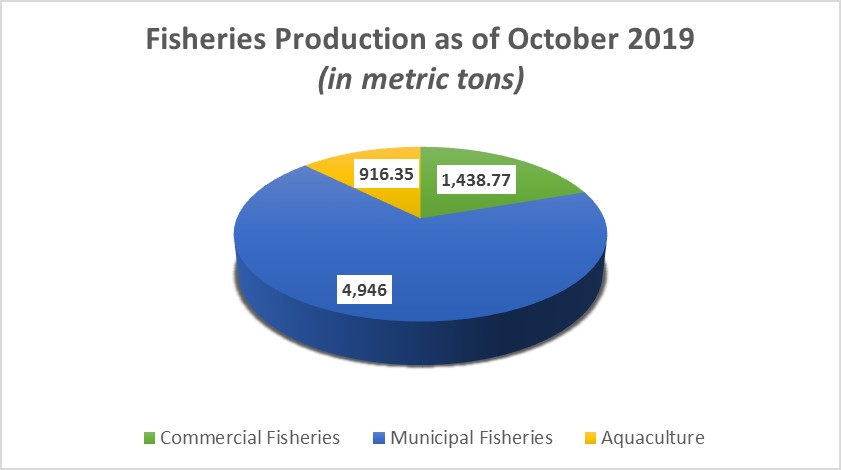
Recorded Satellite images (Visible Infrared Imaging Radiometer Suite) showing no violations in Oriental Mindoro. During the fisheries seasonal closure commercial operations were suspended within the municipal waters of the entire province. Noted violations usually happened during the day where enforcement depends usually to the municipal government and the taskforce operation.
Fish Catch Monitoring Results, Sept. 15 to October 15, 2019
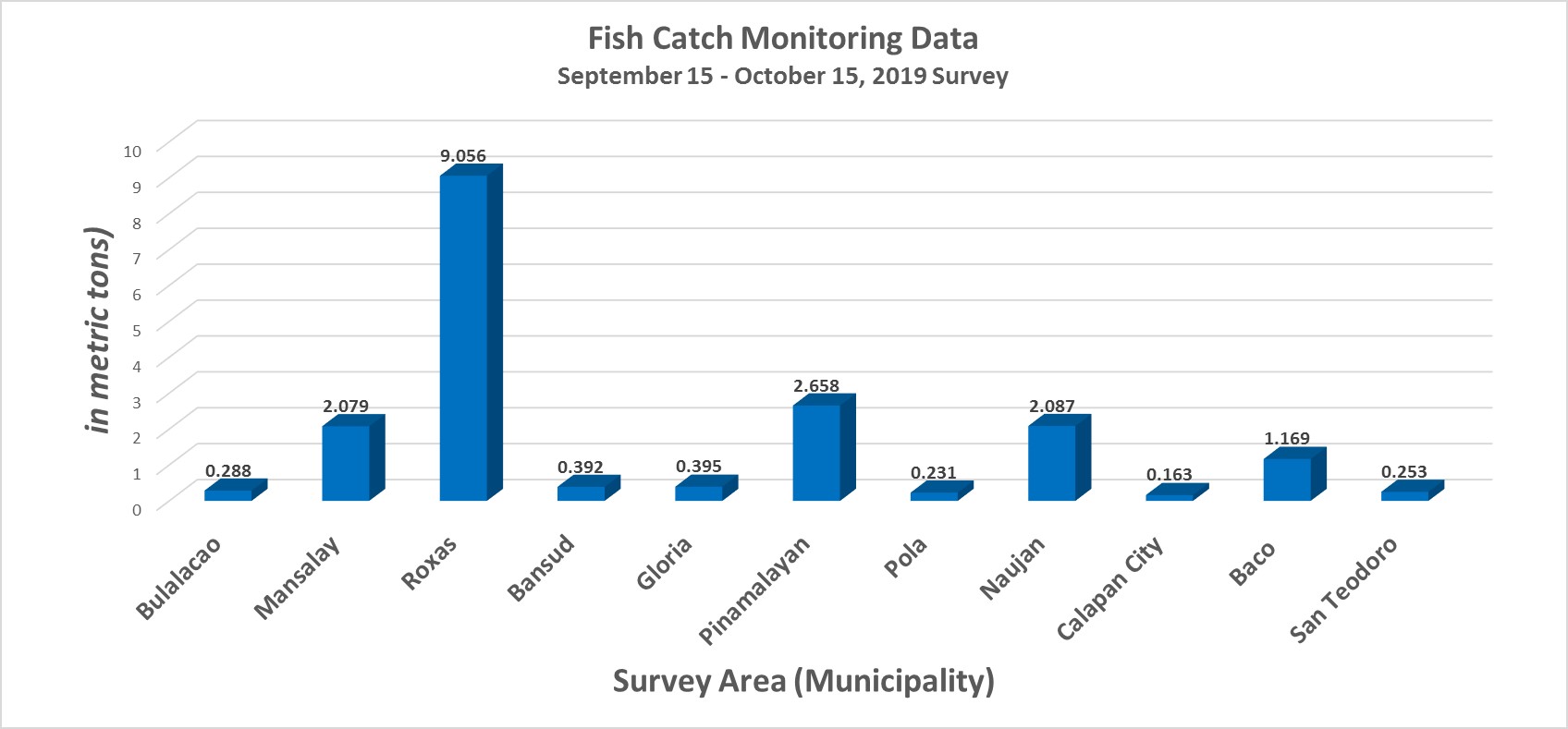
Recorded Satellite images (Visible Infrared Imaging Radiometer Suite) showing no violations in Oriental Mindoro. During the fisheries seasonal closure commercial operations were suspended within the municipal waters of the entire province. Noted violations usually happened during the day where enforcement depends usually to the municipal government and the taskforce operation.
Fish Visual Census
One of the data being monitored in the MPAs of Oriental Mindoro is the data on Fish biomass and density employing the Fish Visual Census method in core zones in the twenty-two (22) established and four (4) proposed MPA sites which have coral reef areas for baseline data on fish biomass, density and diversity estimates. This was first done in 2018 for baseline and in 2019 more sites were surveyed for baseline and for monitoring the increase/decrease of fish population within the monitoring stations (core zones).
Graphs below show that fish biomass in established and well-managed MPAs ranges from high to very high category (21- 40 and above mt/km2) while those newly established and proposed areas fall on very low to low up to moderate (0-20 mt/km2). In comparison, 2019 data (in orange bars), showed general increase from 2018 for fish biomass in all well-managed MPAs. Top 5 MPAs with highest fish biomass are Baco MPA, Calero-Salong Seagrass and Corals MPA (Calapan City), Banilad-Simborio Fish Sanctuary (Pinamalayan), Coral-Garden, Puerto Galera MPA and Maasin MPA (Bulalacao).
Fish Biomass in established and proposed MPAs for 2018 and 2019
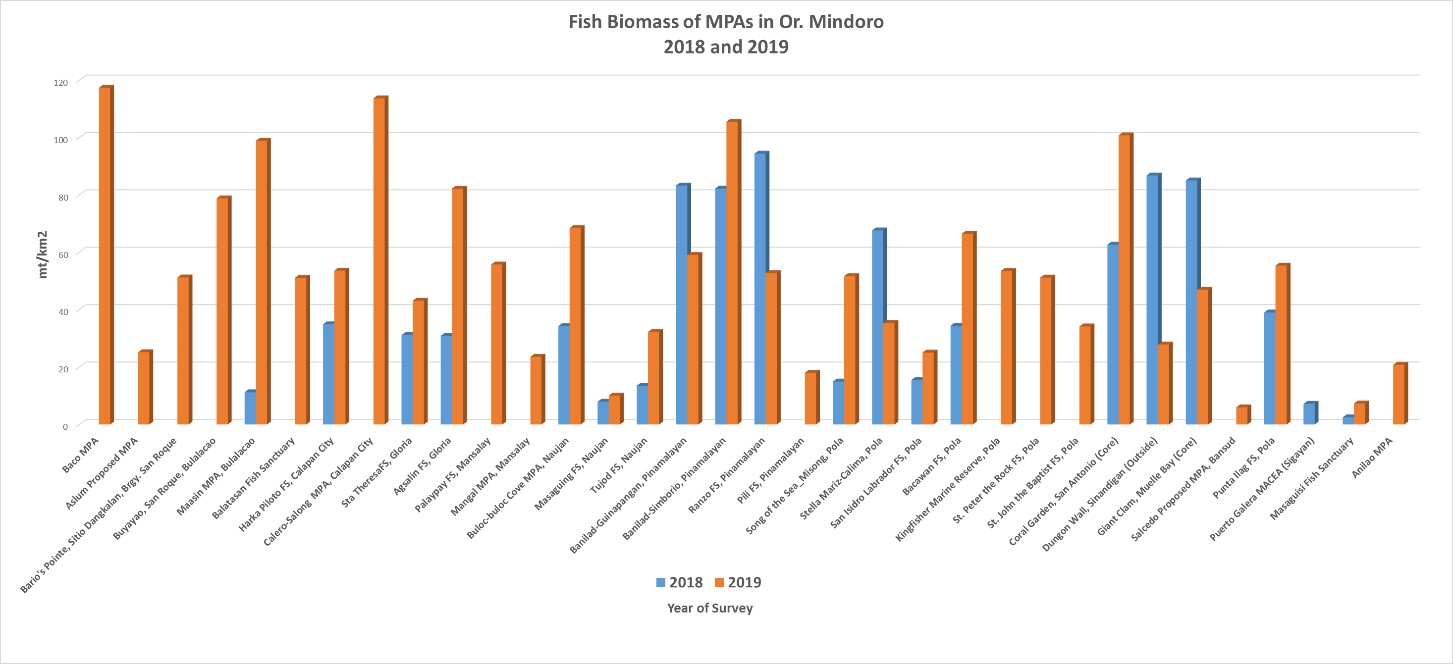
Fish density (no. of individuals within the 500 meter transect) ranges from very poor (177 individuals/500m2) to high category (1,388 individuals/500m2). Buyayao Island in San Roque, Bulalacao, a proposed MPA, exhibited the highest number of individuals counted within the 500 square meter transect, followed by Mangal MPA, core zones of Puerto Galera MPA (Coral Garden and Dungon Wall), Harka Piloto in Calapan City and Kingfisher Marine Reserve in Pola.
Fish Density in established and proposed MPAs
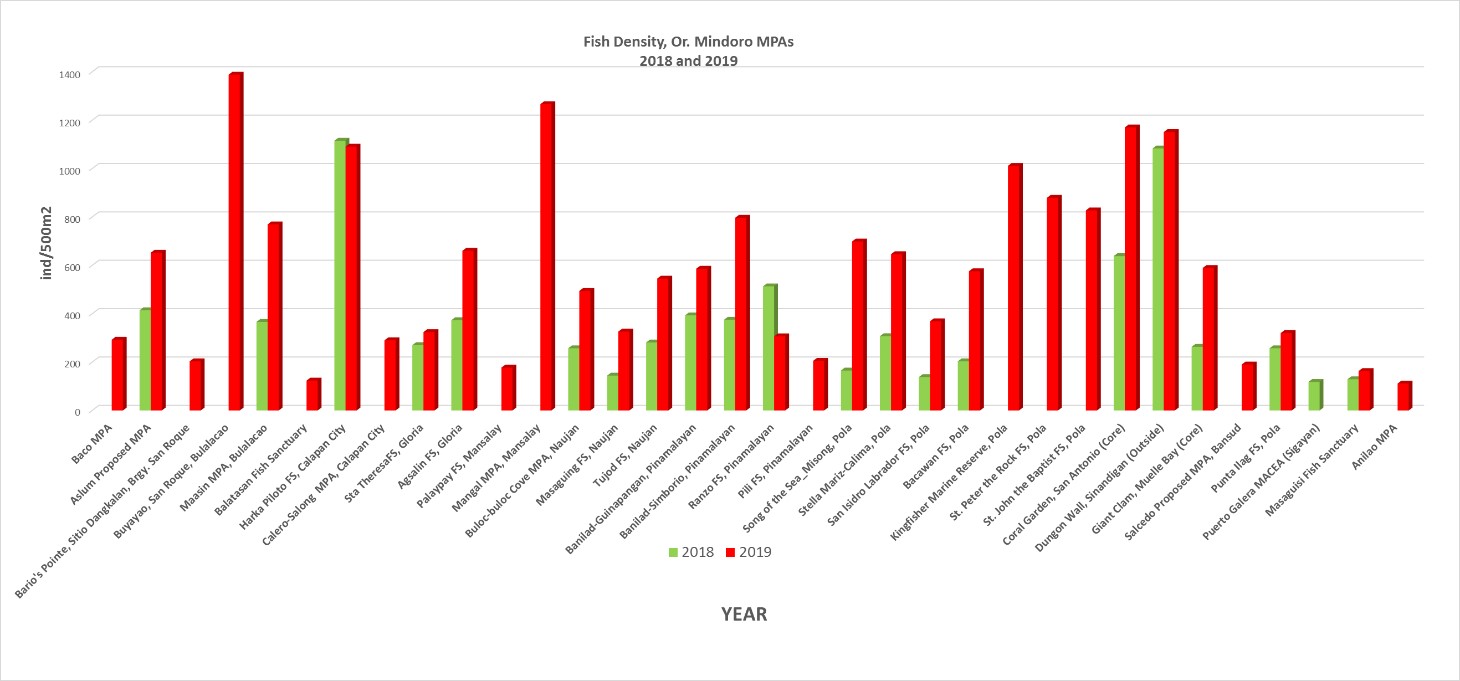
Species diversity in MPAs for 2019 ranges from poor to high category with MPAs in Pinamalayan, Pola, Gloria, and Puerto Galera exhibited highly diverse fish species which ranges from 20 to 70 species identified within the 50-meter and 100-meter transect. While proposed MPA sites in Bulalacao are also considered highly diverse area for fish species. Significant increase of species identified and counted in 2019 (green bars) compared to 2018 (blue bars) within the 500 sq.m. area.
Species richness in established and proposed MPAs
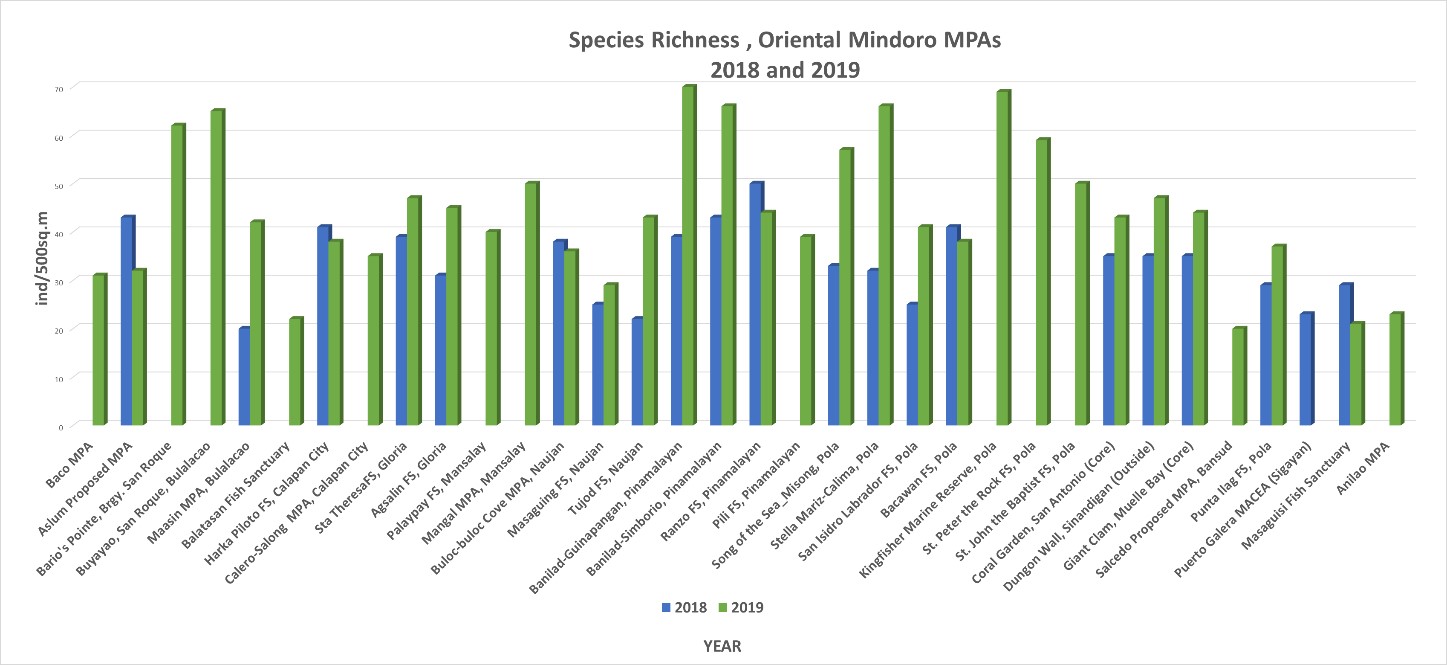
Fish and invertebrates data in 6 surveyed sites (Fig.7) showed that Suguicay Island coral reef is the most diverse in terms of fish indicator species and Aslum Island coral reef has the highest number of Diadema (sea urchins) among 6 sites with 25.25 mean individuals/500m2. Presence of diadema means the area is prone to siltation and algal growth. The least diverse site is Salcedo and Proper Tiguisan reef in Bansud with only 2 fish indicator species noted and crown-of-thorns (coral-eating starfish) observed within the 500 m2 area.
Fish and invertebrates indicator species, March and June 2019
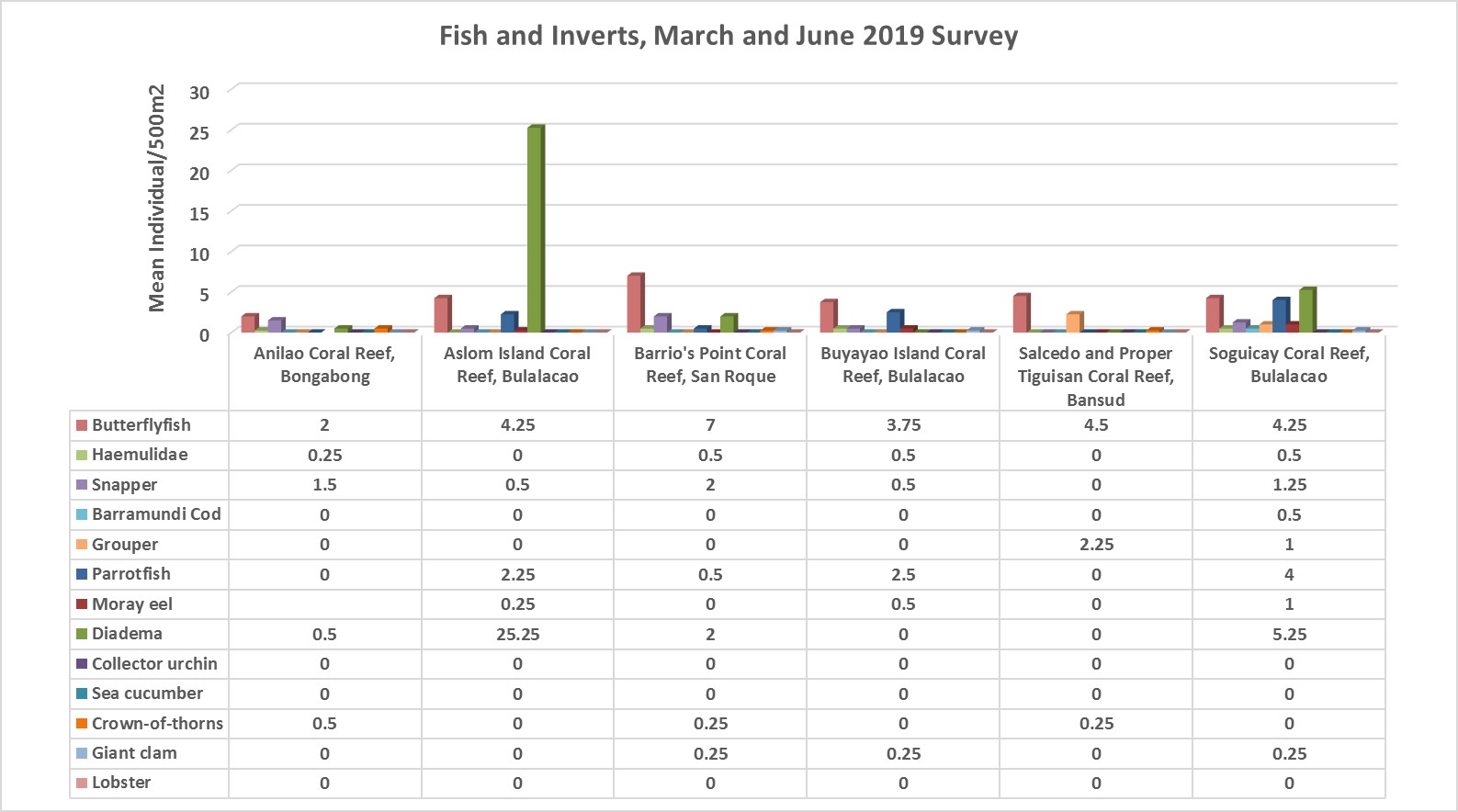
Seagrass Assessment
In March to May 2019, six (6) seagrass sites were assessed to establish data on number of species present in the area, percent cover , canopy height and dominant species. Of the 6 sites assessed, Salong in Calapan City has the most diverse seagrass bed with 9 recorded species followed by Paclasan Roxas with 8 species, and Agsalin with 7 species. The areas are already declared MPAs.
Top 3 dominant species were Thallasia hemprichii (Th) recorded 14 times followed by Halodule pinifolia (Hp) 12 times and Halodule uninervis (Hu) at 9 times.
In terms of canopy height of the dominant species recorded, Enhalus accoroides (Ea) had the highest canopy which measured 29.66 cm at Tagumpay, Pola, followed by Syringodium isoetifolium (Si) at 25.13 at Agsalin, Gloria and Halophila pinifolia (Hp) with canopy length of 24.33 also at Agsalin, Gloria.
Seagrass data gathered by the PAGO and ORMT (March –May 2019)
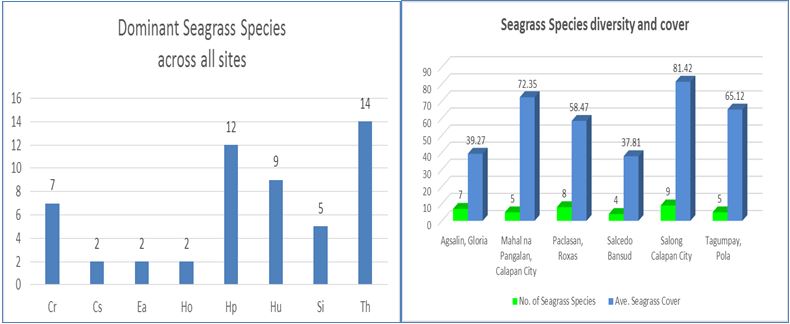
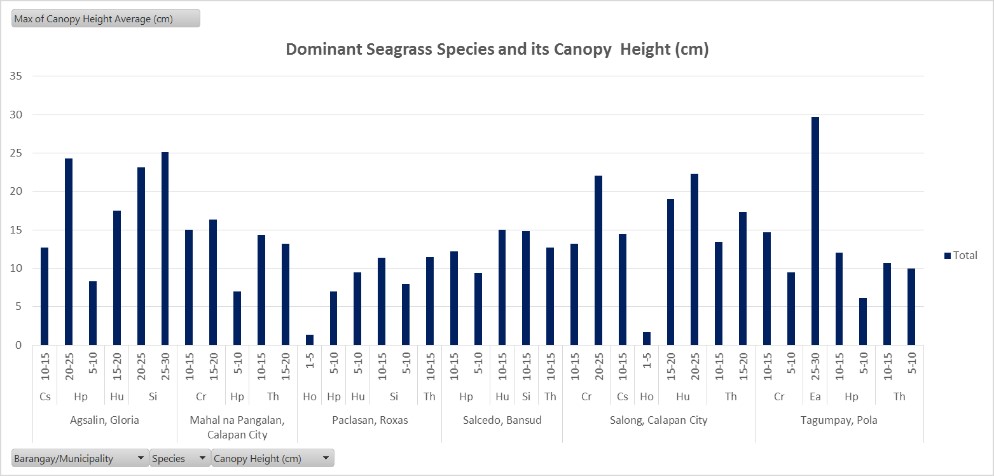
Mangrove Assessment
Mangrove assessment was conducted in Brgy. Wawa, Calapan City, Brgy. Anilao, Ipil, Poblacion in Bongabong in Brgy. Wawa, Calapan City. Assessment was conducted in April and June 2019. The areas were proposed MPAs of Calapan City and Bongabong. There were 9 species recorded in Calapan City and 3 to 6 species in Bongabong. Aviccenia marina is the most dominant species with 271 mature trees. The most diverse area is Wawa, Calapan City and the least diverse is Ipil in Bongabong with only species identified and recorded during the survey.
Population of mangrove species recorded in Brgy. Wawa, Calapan City, Brgy Ipil, Poblacio and Anilao, Bongabong (April and June 2019 Survey)
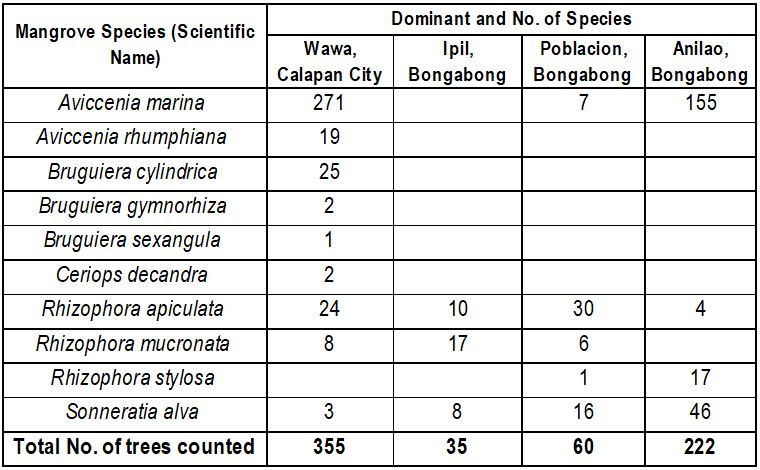
For girth at breast height (GBH), Rhizophora apiculata (Ra), Avicennia marina (Am) and Sonneratia alba (Sa) are the most frequent species from 0-50 across all sites. Avicennia marina (Am) in Anilao, Bongabong with more than 1,600 trees counted and measured followed by Wawa, Calapan City with more than 200 trees counted. Rhizophora apiculata and Rhizophora mucrunata are most frequent in Ipil and Poblacion , Bongabong (Fig. 11-14).
Mangrove Assessment


MARINE PROTECTED AREAS (MPAS)/FISH SANCTUARIES
Survey of live reef and non-living reef cover of MPAs, May 2019
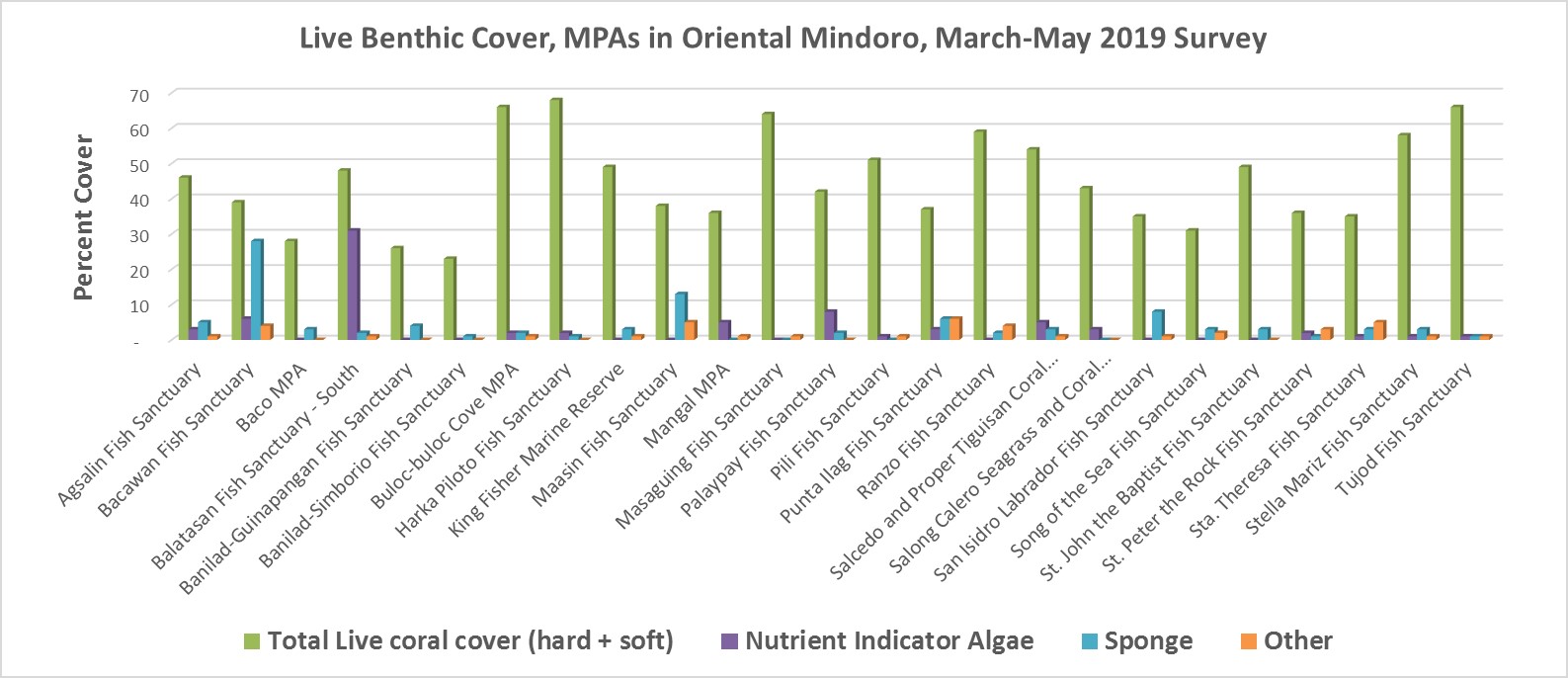
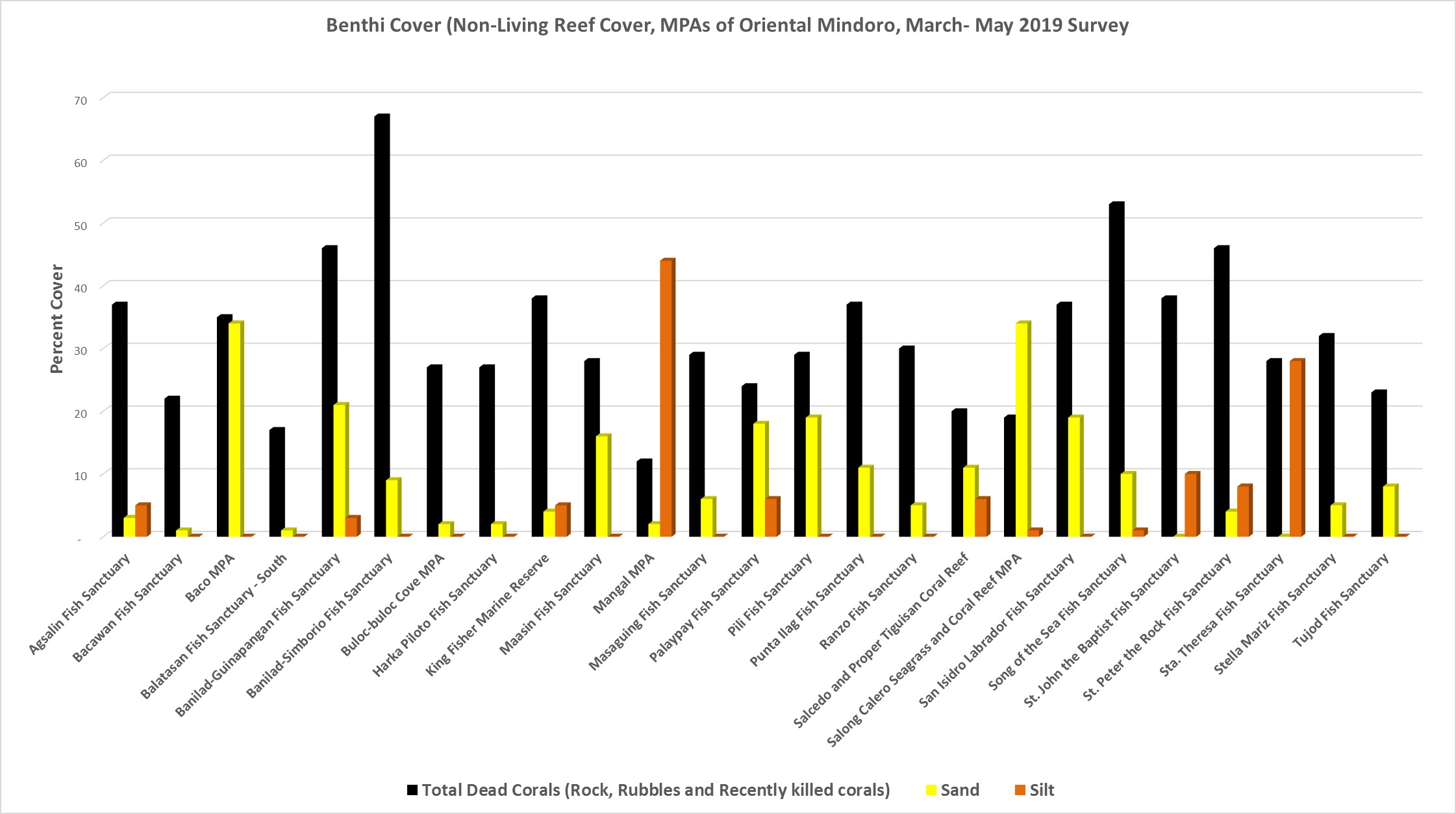
During the second round of surveys conducted in October 2019 (Fig.11-12), the top 5 MPAs with highest live coral cover ranging from 62-91% (very good to excellent) are Harka Piloto Fish Sanctuary, Calapan City, Coral Garden Puerto Galera, Agsalin Fish Sanctuary, Gloria, Ranzo Fish Sanctuary, Pinamalayan and St. John D Baptist, Pola. Total dead coral cover is recorded highest from 38-67% in Balatasan-South, Bulalacao, Giant Clam, Puerto Galera, Banilad-Guinapangan, Pinamalayan, Song of the Sea, Pola and Sta. Theresa, Gloria. Dead corals have potential to recover if algal growth can be minimized by the presence of algal dependent species of fish such as butterflyfish, parrotfish and acanthurids. It wass also observed that silt concentration has lowered in MPAs of Banilad, Sta. Theresa and St. John D Baptist during the October 2019 survey.
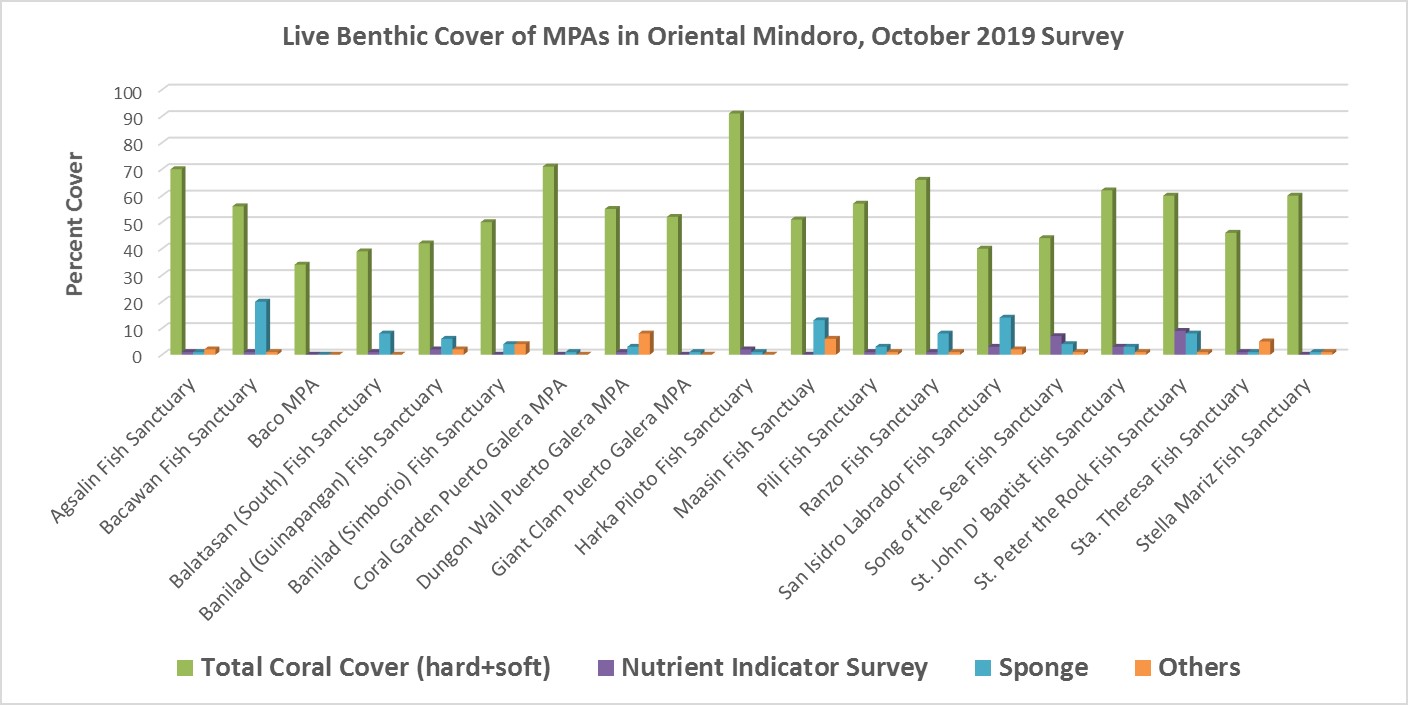
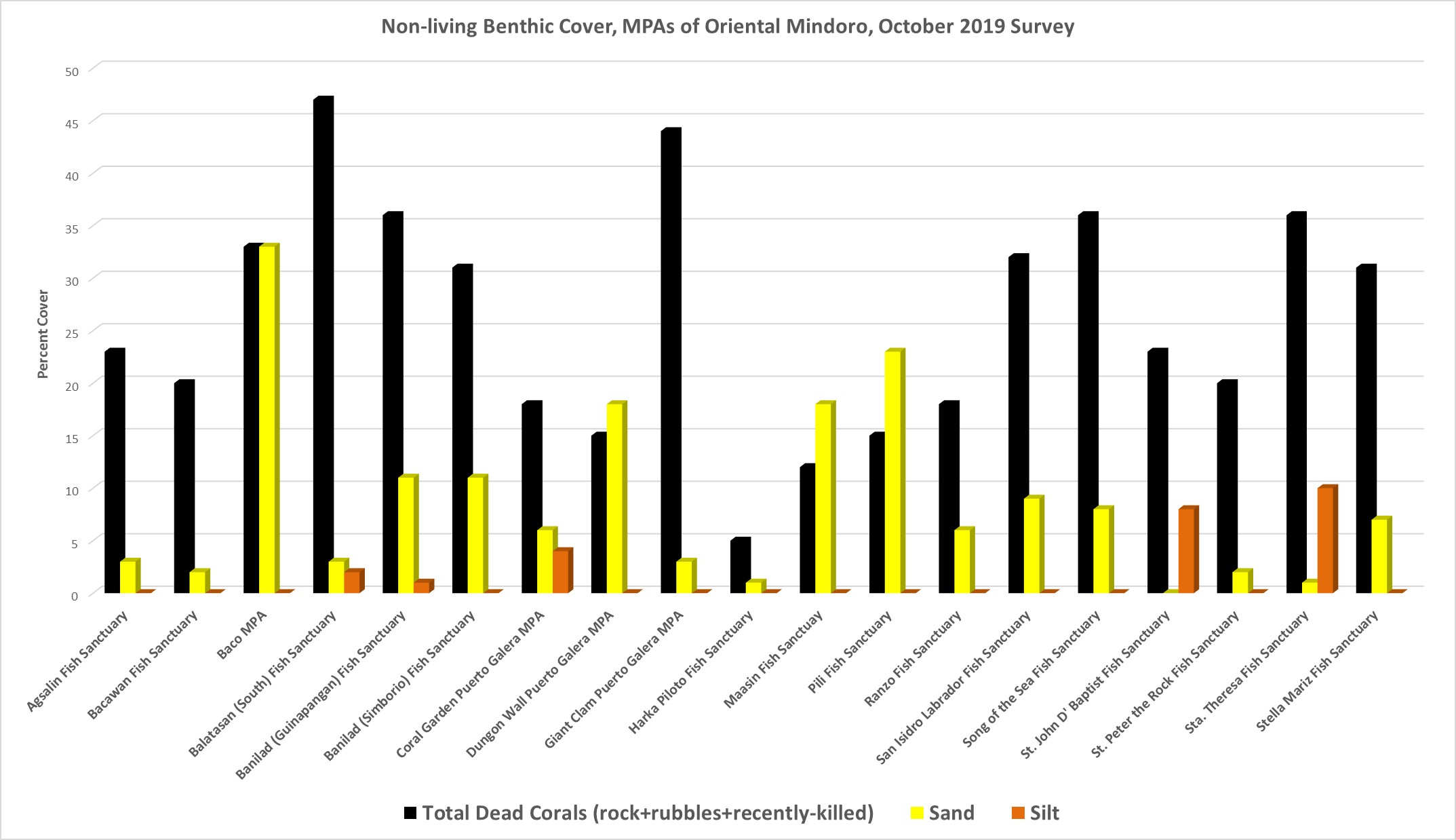
Fish and invertebrates indicator species were also assessed using the reef check method where 9 species of reef fishes and 9 species of invertebrates were counted. These species are reef associated which absence/presence indicate the health of the reefs in an area. Maasin, Punta Ilag and Mangal MPAs, recorded 8 fish indicator species present within the monitoring stations while MPAs with the least species recorded are Masaguing Fish Sanctuary with only 2 indicator species, and Kingfisher Marine Reserve and Masaguisi Fish Sanctuary with 3 indicator species recorded.
Indicator species are absent in Baco MPA, Buloc-buloc MPA and St. Peter the Rock Fish Sanctuary. Most of the MPAs surveyed recorded highest with 4 invertebrates indicator species.
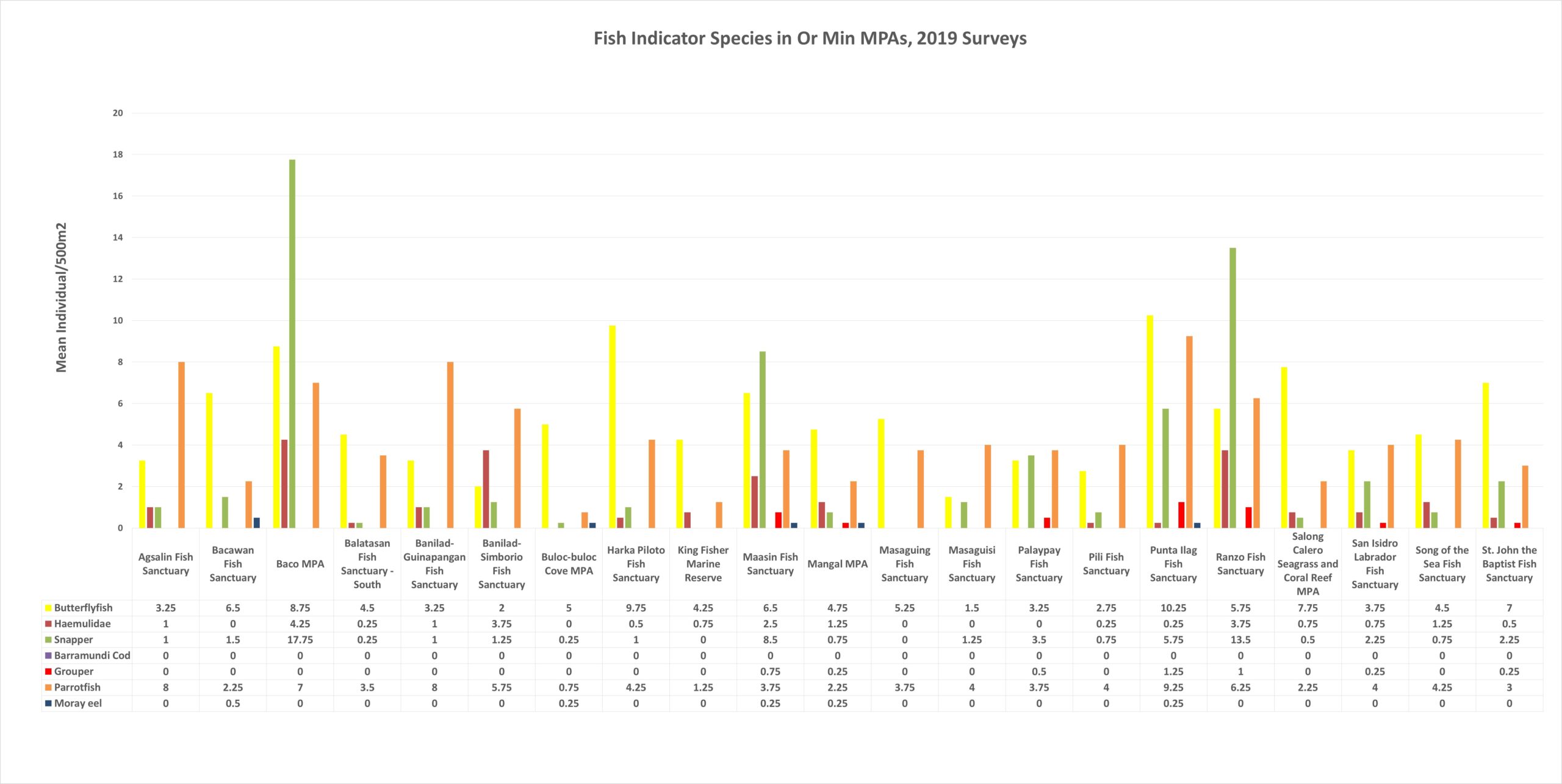
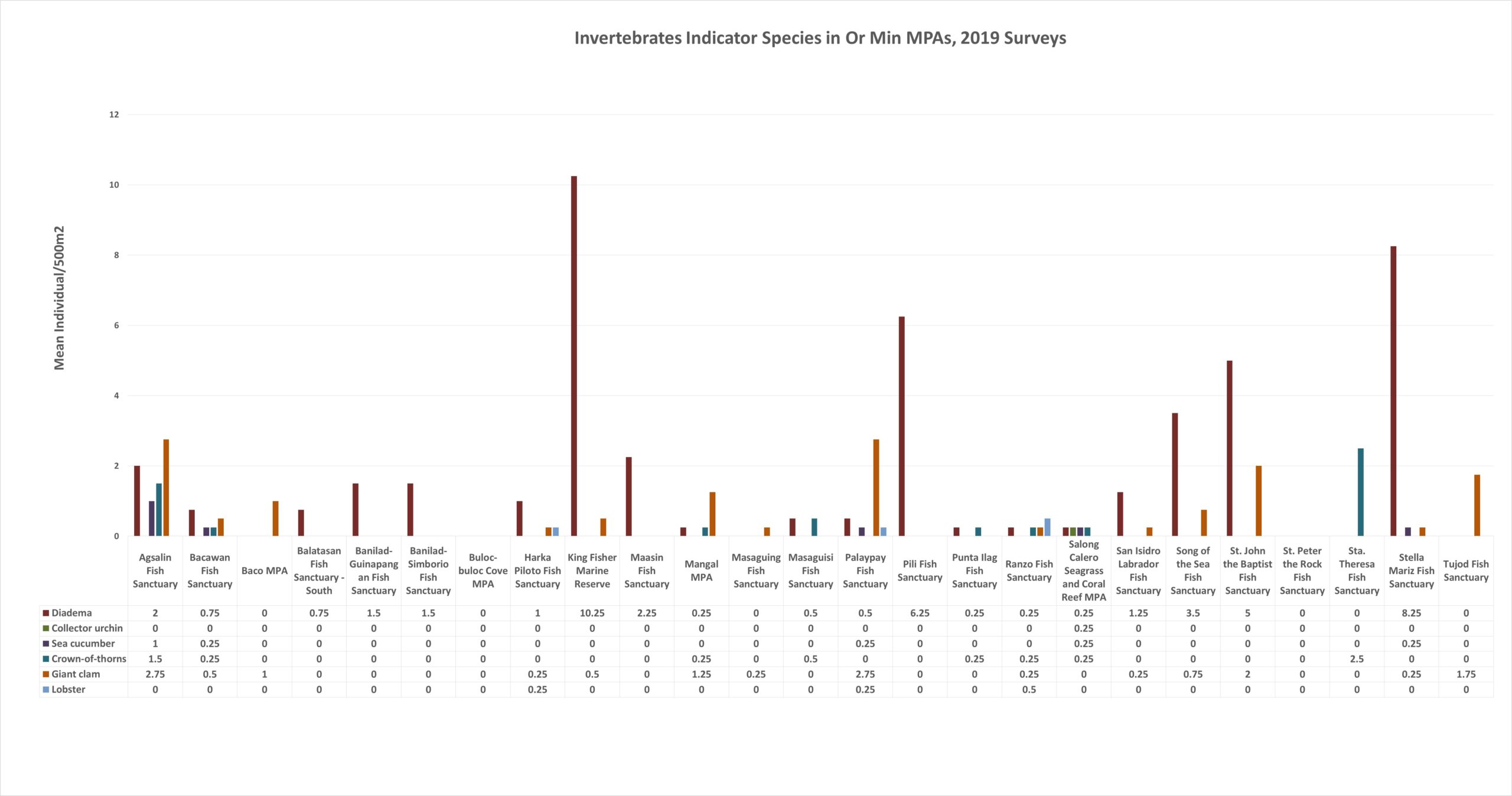
List of established MPAs in Oriental Mindoro
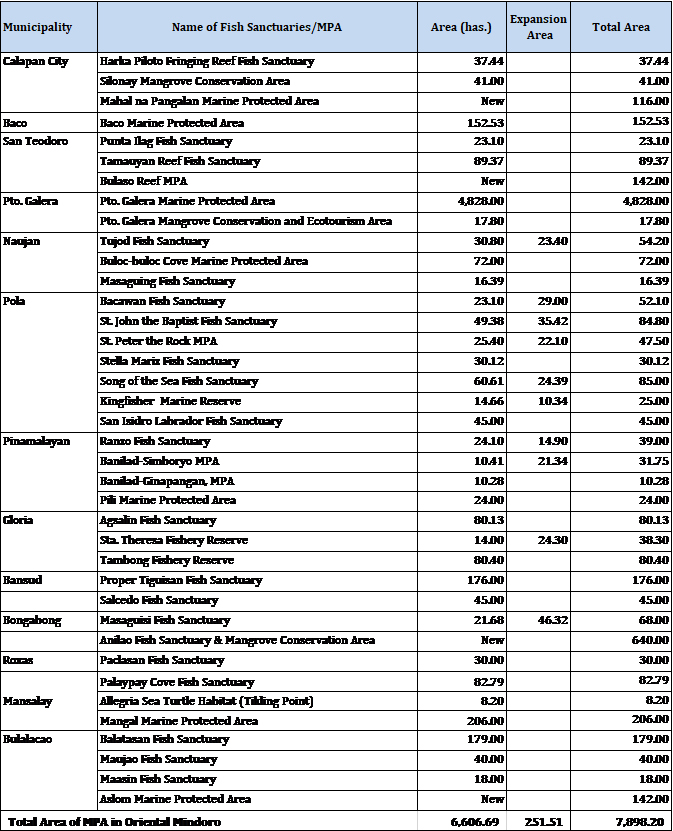
Jump to
- Rice Production
- Corn Production
- Cassava Production
- High Value Crops Production
- Gulayan sa Barangay and Gulayan sa Bakuran
- Fruit Production
- Fisheries Production
- Fish Visual Census
- Fish Biomass
- Fish Density
- Species richness
- Fish and invertebrates indicator species
- Seagrass Assessment
- Mangrove Assessment
- Marine Protected Areas
- List of established MPAs in Oriental Mindoro
Municipalities
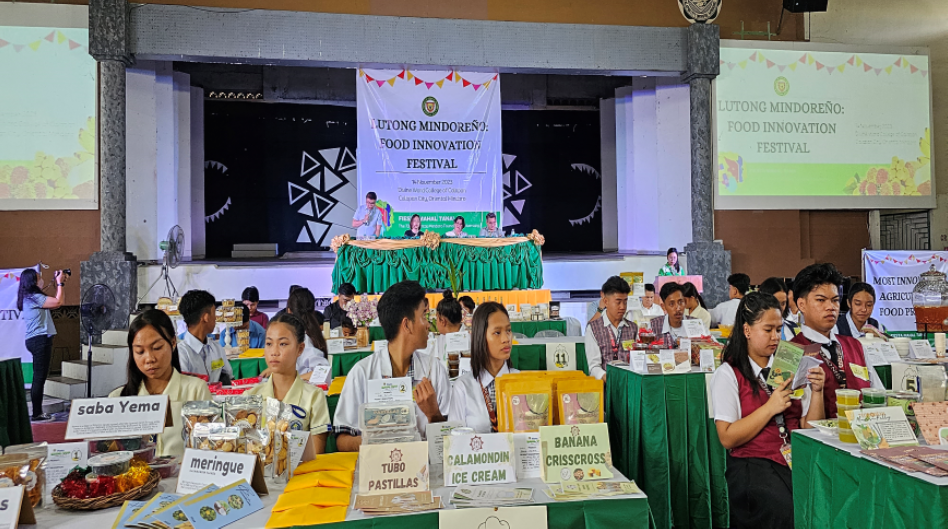
Food Innovation Festival 2023: Lutong Mindoreño
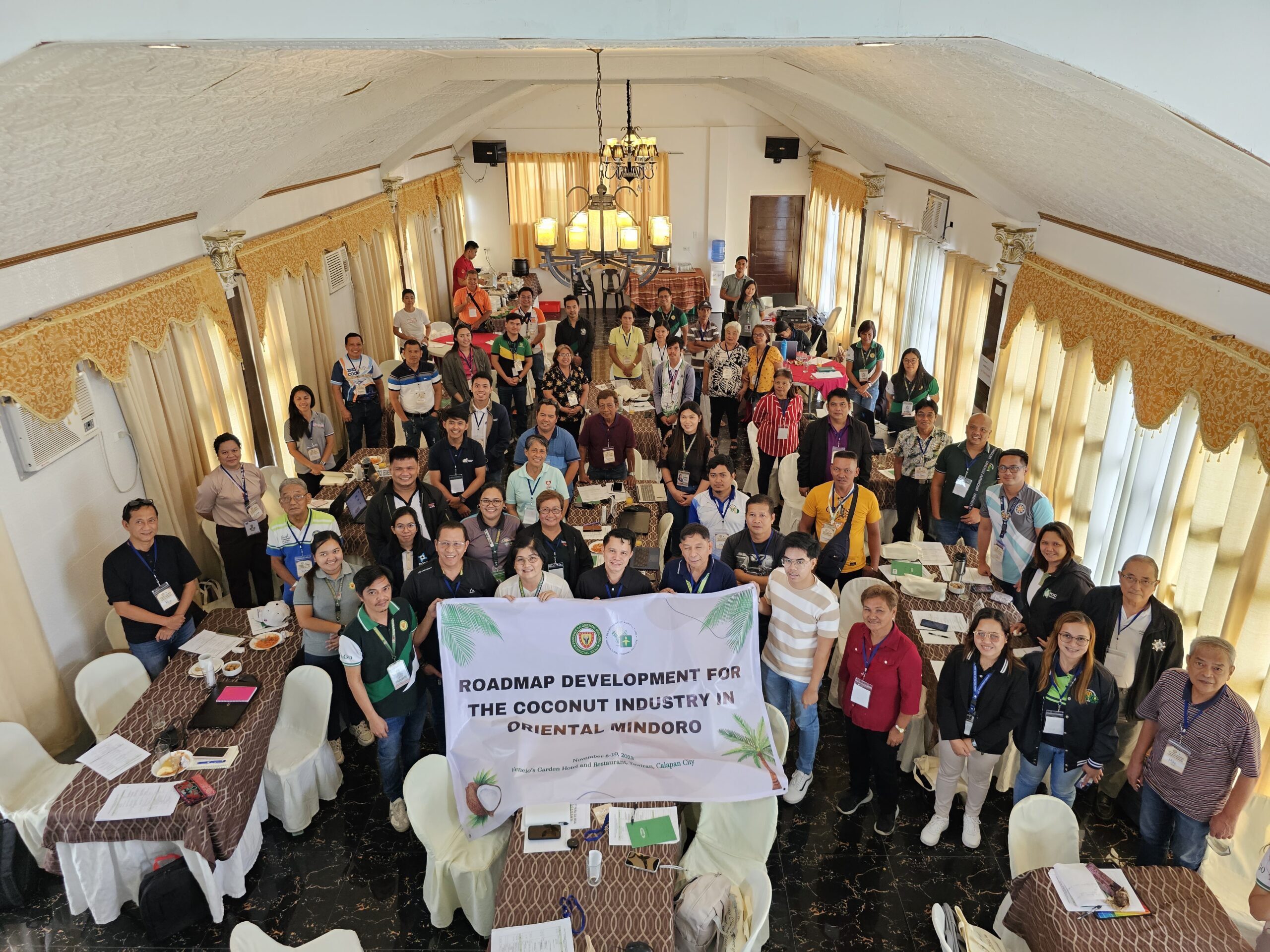
PAGO, ATI pursues Roadmap for Oriental Mindoro Priority Commodities
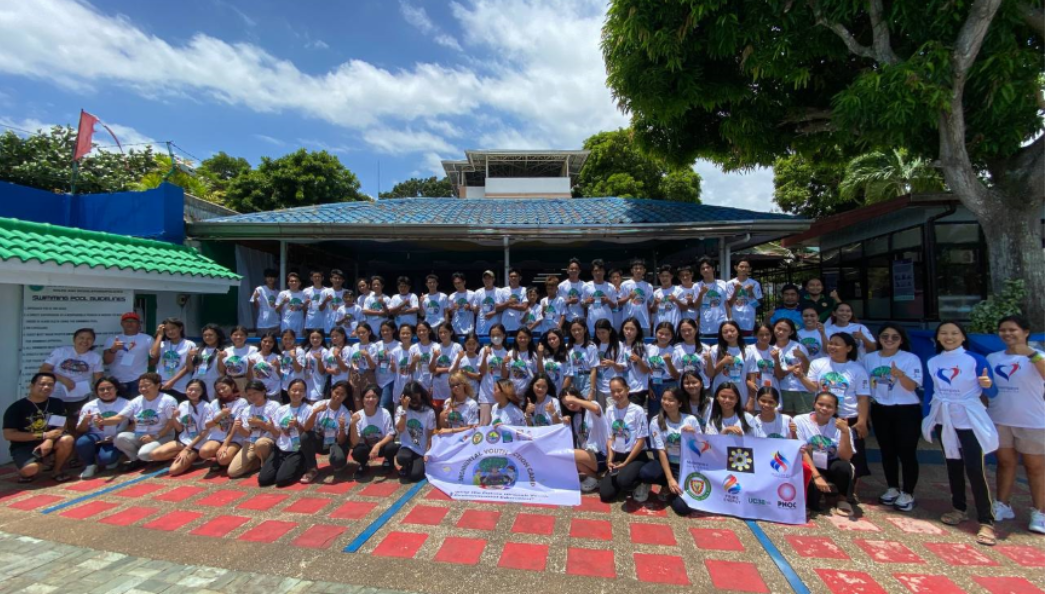
PAGO, MFI Raise MPA Awareness Among Youth
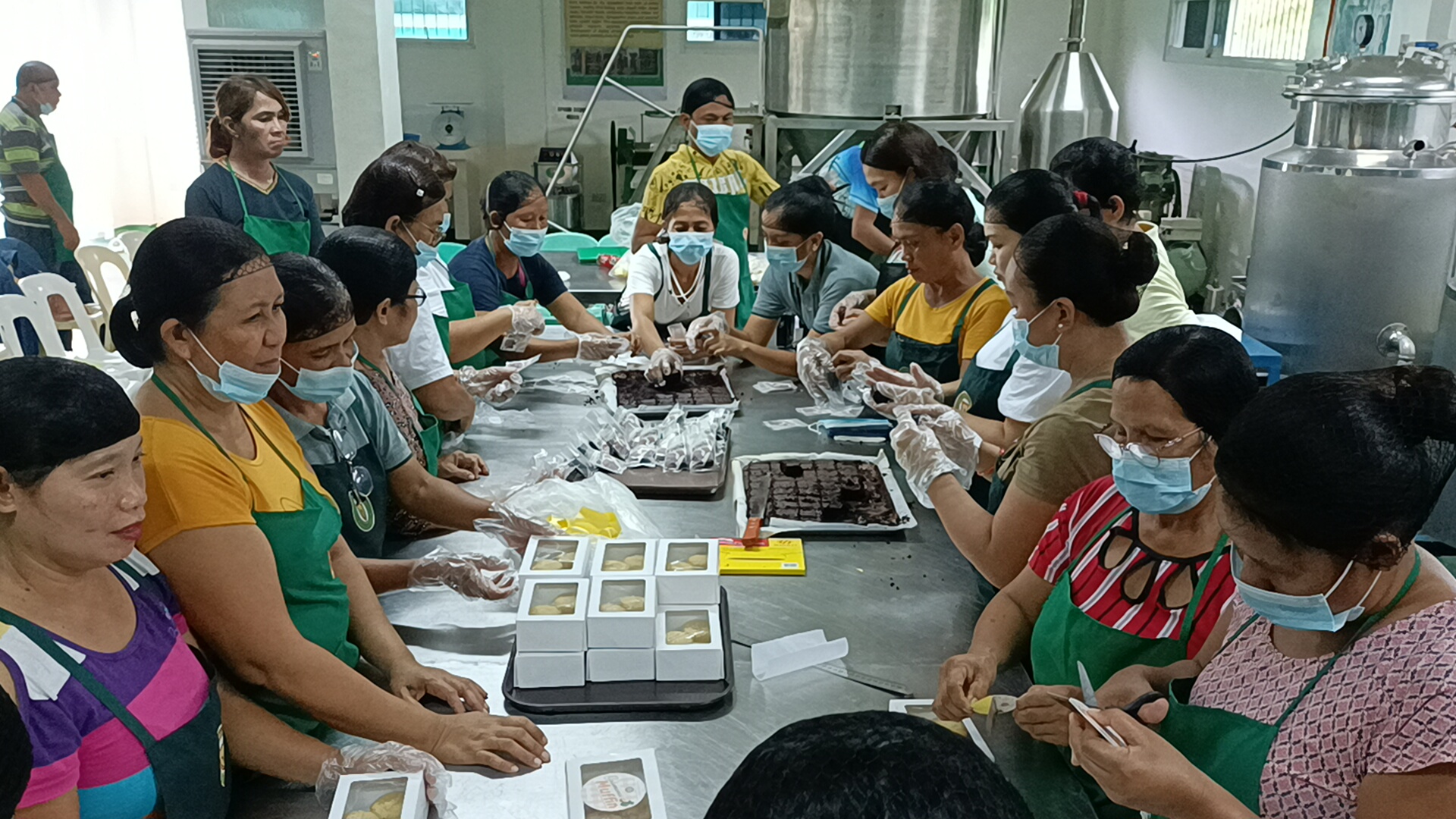
PAGO Empowers Farmers through Innovative Processing Technique
Subscribe to our AgriInfoHub newsletter and receive the latest updates, expert insights, and valuable tips to cultivate success on your farm.
